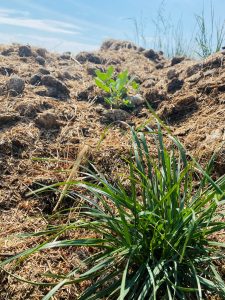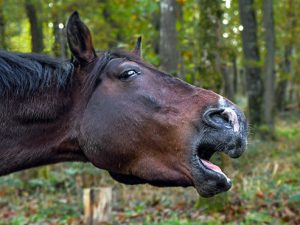
Sustainable Manure Management for Horse Farms in the U.S.: An Eco-Friendly Solution with EQuiFIMUS
With approximately 9 million horses in the United States, vast

Laminitis occurs when the sensitive connective tissue in the hoof, the laminae, becomes inflamed, resulting in the separation of the coffin bone from the hoof wall. This condition is often linked to metabolic disorders, obesity, or improper feeding, but it can also be caused by other factors.
Laminitis is a very painful condition that can drastically affect a horse’s mobility and quality of life. To protect your horse from this disease, it’s important to understand the risk factors and the preventive measures that can be taken to minimize the risk.
Causes of Laminitis
Laminitis can be triggered by a range of factors, but the most common causes include:
Overfeeding on Sugars and Starches
One of the most common causes of laminitis is excessive intake of sugars or starches, particularly from pasture grass or grain-based feed. When a horse consumes too much sugar or starch, it breaks down in the gut and can cause an imbalance in the microbiome, releasing toxins into the bloodstream that negatively affect the hooves.
Obesity
Overweight horses are at a significantly higher risk of developing laminitis. Obesity increases the strain on the hooves and contributes to insulin resistance, a condition in which the horse’s body cannot effectively regulate blood sugar levels. Insulin resistance is directly linked to laminitis.
Endocrine Disorders
Horses with metabolic disorders such as Equine Metabolic Syndrome (EMS) or Cushing’s disease (PPID) are at an increased risk of developing laminitis. These conditions affect the horse’s hormone balance, which can lead to elevated insulin levels that negatively impact blood circulation in the hooves.
Stress or Overload
Stressful situations, such as illness, prolonged stall rest, or extreme exercise, can also contribute to the development of laminitis. Sometimes, laminitis is triggered after another serious illness or injury where the horse has been severely overburdened on one or more hooves.
Symptoms of Laminitis
Early signs of laminitis can be subtle, but it’s important to watch for symptoms such as:
If you suspect your horse has laminitis, you should contact a veterinarian immediately to get a proper diagnosis and treatment plan.
How to Reduce the Risk of Laminitis
To reduce the risk of laminitis, it’s important to implement preventive measures. Here are some strategies you can use to keep your horse healthy and minimize the risk of developing laminitis:
Controlled Feeding and Feed Ration Planning
Carefully monitoring your horse’s diet is crucial. Limit the amount of sugar and starch in your horse’s feed, especially for horses that are overweight or have metabolic disorders. It’s also important to create a feed ration plan and choose suitable forage. On our website, you can easily create a feed ration plan using our EQuiOpt tool, where you can input your own forage and supplement values. This tool helps you calculate an optimal daily feed ration based on your horse’s individual needs. If you need help with creating a feed plan or have any questions, feel free to contact us—we’re happy to assist.
Limited Grazing Time
If your horse is prone to laminitis or overweight, you may need to limit grazing time, especially during periods when the grass is most nutrient-rich, such as in the morning and evening during spring and summer. Night grazing or limiting turnout time in the pasture can also help control sugar intake.
Monitoring Your Horse’s Weight
Regular weight checks and body condition assessments are important to catch weight gain early and adjust feeding and exercise accordingly. Overweight horses should be placed on a controlled weight loss program, often with the help of a veterinarian or nutritionist.
Regular Exercise
Exercise is a key part of keeping your horse healthy and preventing obesity, which is a risk factor for laminitis. Regular, low-intensity exercise can help regulate blood sugar levels and improve your horse’s overall health. Even if the horse is not being ridden, daily movement such as walking or free movement in a paddock can be beneficial.
Managing Endocrine Disorders
If your horse is diagnosed with Equine Metabolic Syndrome or Cushing’s disease, it is important to work closely with your veterinarian to develop a long-term treatment plan. Treatment may include medication, dietary changes, and other measures to manage insulin levels and prevent laminitis attacks.
Hoof Care and Monitoring
Regular hoof care is essential for maintaining hoof health and detecting early signs of laminitis. Ensure your farrier regularly inspects your horse’s hooves and addresses any changes in hoof structure or shape.
Summary
Laminitis is a serious and painful disease that can affect a horse’s quality of life. By taking preventive measures, such as monitoring your horse’s diet with a carefully calculated feed plan, maintaining a healthy weight, and ensuring regular exercise, you can significantly reduce the risk of developing laminitis. Recognizing early signs of laminitis and acting promptly if you suspect your horse may be affected is also crucial to preventing more severe complications.
Always consult your veterinarian if you have concerns about your horse’s health and laminitis risk factors!
Read more: What-to-feed-a-horse-with-laminitis

With approximately 9 million horses in the United States, vast

Go back Optimizing Stable Environments: Flax Bedding as a Key

The 2024 U.S. hay market shows regional imbalances, with states